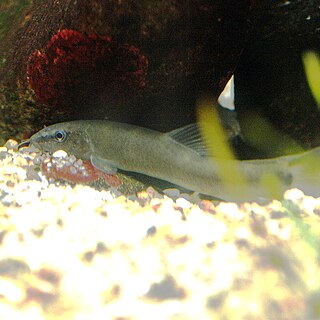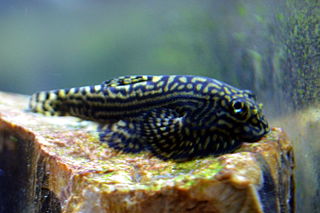
Cypriniformes is an order of ray-finned fish, which includes many families and genera of cyprinid fish, such as barbs, gobies, loaches, botias, and minnows. Cypriniformes is an “order-within-an-order”, placed under the superorder Ostariophysi—which is also made up of cyprinid, ostariophysin fishes. The order contains 11-12 families, over 400 genera, and more than 4,250 named species; new species are regularly described, and new genera are recognized frequently. Cyprinids are most diverse in South and Southeast Asia, but are entirely absent from Australia and South America. At 112 years old, the longest-lived cypriniform fish documented is the bigmouth buffalo.

Cobitidae, also known as the True loaches, is a family of Old World freshwater fish. They occur throughout Eurasia and in Morocco, and inhabit riverine ecosystems. Today, most "loaches" are placed in other families. The family includes about 260 described species. New species are being described regularly.

The clown loach, or tiger botia, is a tropical freshwater fish belonging to the botiid loach family. It is the sole member of the genus Chromobotia. It originates in inland waters in Indonesia on the islands of Sumatra and Borneo. In Sentarum, West Borneo that fish named: ulanguli. It is a popular fish in the freshwater aquarium trade and is sold worldwide.

The spined loach is a common freshwater fish in Europe. It is sometimes known as spotted weather loach, not to be confused with the "typical" weather loaches of the genus Misgurnus. This is the type species of the spiny loach genus (Cobitis) and the true loach family (Cobitidae).

The pond loach, also known as the Dojo loach, oriental weatherloach or oriental weatherfish, is a freshwater fish in the loach family Cobitidae. They are native to East Asia, but are also popular as an aquarium fish and introduced elsewhere in Asia and to Europe, America and Australia. The alternate name weather loach is shared with several other Cobitidae, including the other members of the genus Misgurnus and the spotted weather loach. This term comes from their ability to detect changes in barometric pressure before a storm and react with frantic swimming or standing on end.

The stream catfishes comprise the family Akysidae of catfishes.

The loach catfishes are a family, Amphiliidae, of catfishes. They are widespread in tropical Africa, but are most common in streams at high elevations; most species are able to cling to rocks in fast-flowing streams. The 13 genera contain 68 species.

Cobitis is a genus of small freshwater fish in the family Cobitidae from temperate and subtropical Eurasia. It contains the "typical spiny loaches", including the well-known spined loach of Europe. Similar spiny loaches, occurring generally south of the range of Cobitis, are nowadays separated in Sabanejewia.

The ayumodoki or kissing loach is a species of ray-finned fish in the family Botiidae. It is found in lakes and streams on Honshu, the largest island in Japan. Spawning grounds for kissing loach are ditches and small reservoirs for rice cultivation of a river system located in Japan. The kissing loach migrates to flooded areas, including paddy field areas, for spawning in early summer and the spawning of this species is limited after the formation of flooded areas over terrestrial vegetation. These flooded areas are the result of water from mountain streams and irrigation ponds flooding once dry land which create creating man-made wetlands. As, adults, Parabotia curtus migrate from these flooded paddy fields to fast moving, muddy streams and rivers like the Yodo River.

The stone loach is a European species of fresh water ray-finned fish in the family Nemacheilidae. It is one of nineteen species in the genus Barbatula. Stone loaches live amongst the gravel and stones of fast flowing water where they can search for food. The most distinctive feature of this small fish is the presence of barbels around the bottom jaw, which they use to detect their invertebrate prey. The body is a mixture of brown, green and yellow.

Schistura is a genus of fish in the stone loach family Nemacheilidae native to the streams and rivers of the southern and eastern Asia. Some of these species are troglobitic.

Schistura mahnerti is a species of tropical freshwater fish of the stone loach family Nemacheilidae. It inhabits fast-flowing streams of Thailand and Myanmar (Burma). S. mahnerti is one of the more recent species to be introduced to the aquarium trade.
Triplophysa siluroides is a large species of stone loach, which is endemic to the upper parts of the Yellow River basin in the Chinese provinces of Qinghai, Gansu and Sichuan.
The true Kuhli loach, occasionally referred to as eel loach, is a small eel-like freshwater fish belonging to the loach family (Cobitidae). They originate from the island of Java in Indonesia. This snake-like creature is very slender and nocturnal.

Loaches are fish of the superfamily Cobitoidea. They are freshwater, benthic (bottom-dwelling) fish found in rivers and creeks throughout Eurasia and northern Africa. Loaches are among the most diverse groups of fish; the 1249 known species of Cobitoidea comprise about 107 genera divided among 9 families.

The Gobionellinae are a subfamily of fish which was formerly classified in the family Gobiidae, the gobies, but the 5th Edition of Fishes of the World classifies the subfamily as part of the family Oxudercidae. Members of Gobionellinae mostly inhabit estuarine and freshwater habitats; the main exception is the genus Gnatholepis, which live with corals in marine environments. The subfamily is distributed in tropical and temperate regions around the world with the exception of the northeastern Atlantic Ocean, the Mediterranean Sea, and the Ponto-Caspian region. It includes around 370 species and 55 genera: Wikipedia articles about genera list about 389 species.
Mesonoemacheilus is a genus of stone loach endemic to India.

Neohomaloptera johorensis is a species of dwarf hillstream loach, it is the only member of its genus Neohomaloptera.

Sewellia is a genus of fish in the family Gastromyzontidae. They are commonly called hillstream loaches and are found in Laos and Vietnam. According to Roberts (1998) a possible defining characteristic of the genus Sewellia is their posterior pelvic valve is highly complex and different from other rheophilic loaches, their posterior pelvic valve involves the overlapping of the second to last ventrally exposed rays. Adapted to high velocity streams, Sewellia have depressed body shapes that are laterally expanded, thus increasing their hydrodynamical properties and allowing them to better stay attached to rocks in swift current. Sewellia also have paired fins with a single simple ray and numerous branched rays allowing them to grip rocks in swift current.
The large-scale loach is a species of true loach that is native to Mainland China, Hainan, Taiwan, Korea, and the Russian Far East. It can be found in water bodies such as the Yangtze Basin, Pearl River, Amur River, and various other drainages. There are several known invasive populations in places such as Barcelona, the San Joaquin River in California, and the majority of Japan. The large-scale loach is typically brown, grey, or golden in color with mottled or speckled black dots, which leads to it sometimes called a "peppered loach" when sold at pet stores. It is a small loach, growing between 7.3 to 15.4 cm TL.















